Text
Counting on the Woods by George Ella Lyon, photographs by Ann W. Olson
The poetic phrases in this book provide a great opportunity to expose your child to new vocabulary. Hearing and seeing unique words can help expand your child's understanding of reading.
The photographic artwork provides visuals you can count with your child. Ask your child to use their background knowledge by pointing to any familiar animals and plants; can they identity what is in the pictures?
Expand the Reading- Make a Nature Viewer!
Supplies Needed:
cardboard/cardstock or other heavyweight paper
coloring supplies
scissors
Cut a small hole in your piece of cardboard, and decorate your Nature Viewer. You can draw pictures of plants and animals you expect to find outside.

Once you've finished, take your Nature Viewer outside and look through the hole. What do you see? Talking to your child about the nature right outside their home can help build background knowledge.
Try playing a game by seeing how different types of leaves or bugs you can spot with your Nature Viewer.
Check out Counting on the Woods
#counting on the woods#george ella lyon#ann w. olson#kids' books#photography books#nature books#poetry#kids' crafts#ecrr extension activities#vocab builder#background knowledge#talking#playing
1 note
·
View note
Text
Daniel Finds a Poem by Micha Archer
April is National Poetry Month! Daniel wants to figure out what poetry is, so he asks his animal friends in the park.
This colorful book's illustrations will delight young children who can share their background knowledge about the featured animals. Adults can point to the pictures and ask children to identify the animals or ask follow up questions like “What does this animal eat?” Try talking about the animals you see on the pages or in your own yard or park.
Extend the Book by Writing a Poem!
Supplies Needed:
Paper
writing or coloring utensils
Ask your child to help you write a poem about an animal. You can take turns coming up with the words for the poem, or let your child dictate the whole thing.
Remember, just like Daniel's poem in the book, not all poems need to rhyme!

Let your child practice their writing skills by drawing an illustration to go with your new poem.
Check out Daniel Finds a Poem
#daniel finds a poem#micha archer#background knowledge#talking#writing#writing practice#kids' books#ecrr extension activities#every child ready to read#early literacy
0 notes
Text
The Rainbow Snail by Karin Åkesson
The Rainbow Snail is a brightly illustrated picture book with easy-to-read text that is great for teaching colors to toddlers and preschoolers.
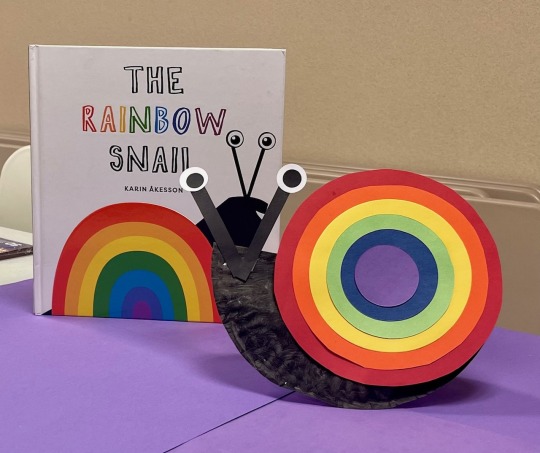
We follow the charming snail and discover all the colors of the rainbow. This book promotes vocabulary and background knowledge.
This book also encourages talking and playing as you describe the different colors of the rainbow: blue like the raindrops, green like the grass and yellow like the sun.
Extend this book by making a rocking rainbow snail
What you will need:
paper plate
white, black, red, orange, yellow, green, blue and purple construction paper
scissors
tape or glue
black paint
Fold the paper plate in half.
Paint the plate black to match the snail in the book.
Cut out paper circles making the red one the biggest and purple the smallest.
Cut out black strips. Cut out white and black circles for the eyes.
Glue or tape pieces together.
Glue or tape the circles and the eyes on the plate.

#the rainbow snail#Karin Åkesson#kids' books#ecrr extension activities#paper plate craft#background knowledge#vocab builder#talking#playing#snail#picture books#learning colors#book recommendations
2 notes
·
View notes
Text
Invisible Things by Andy J. Pizza & Sophie Miller
This New York Times Bestselling picture book is a colorful, whimsical exploration of all those things we can't see.
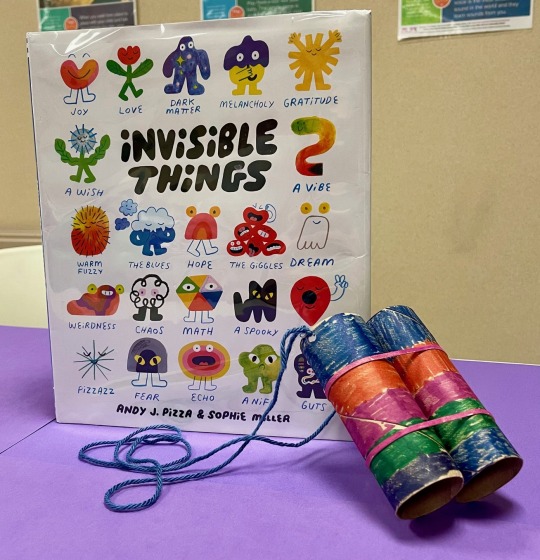
What if we could see feelings, or the sound of a dog barking or the taste of a lollipop? The authors encourages the reader to use all their five senses.
This a great book to read to preschoolers of all ages. As the child gets older they will be able to use their imagination to “see” all the wonderful invisible things around them. This promotes vocabulary and background knowledge.
This book encourages talking. Ask your child “How would you draw love or hope?” or “What are the things you can hear but not see?”
Extend the book with a special pair of binoculars
On the inside cover, readers of this book are encouraged to put on a pair of special glasses to see invisible things. You can extend the book by actually making a pair of special binoculars.
What you will need:
2 toilet paper rolls (or a paper towel roll cut in half)
2 rubber bands
crayons or markers
yarn
hole punch

Color the cardboard rolls using markers or crayons.
Put the rolls together with two rubber bands.
Make a hole on the far side of each roll.
Tie yarn to each hole so you can put keep the binoculars around your neck.
Find your favorite invisible thing in the book!

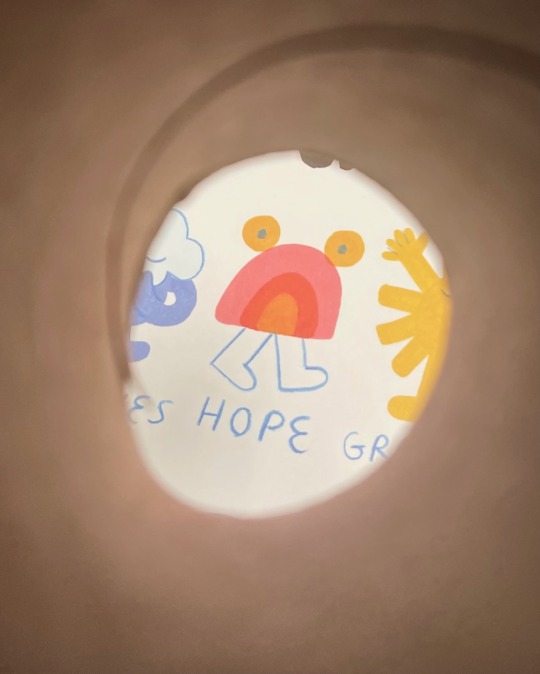
#invisible things#andy j. pizza#sophie miller#kids' books#vocab builder#background knowledge#talking#ecrr extension activities#book recommendations
0 notes
Text
Robot in Love by T.L. McBeth
This book is about a robot who sees his true love while walking through town. He thinks about her for a day, talks to her the next, and then he decides he will bring her flowers.
To his heartbreak, she is missing and he looks everywhere. He walks into a nearby store and he finally sees her! You will have to read the story to see the hilarious twist.
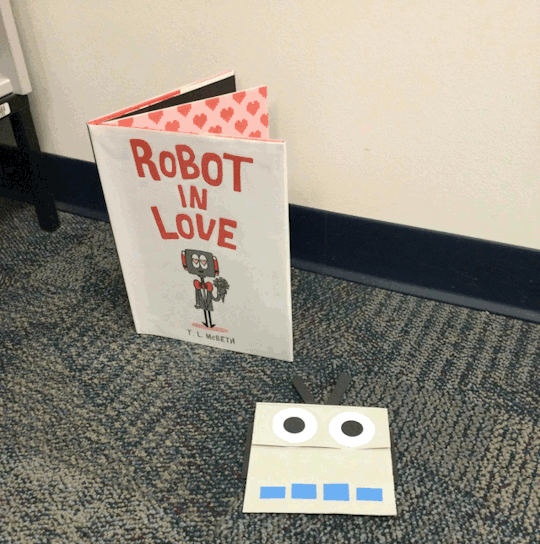
Robot in Love will help build print awareness, vocabulary, and narrative skills.
This book also builds early literacy skills such as talking, reading, and playing.
Extend the book by building a paper robot.
What you will need:
1 Black sheet of paper
1 White sheet of paper
1 Pink or Red sheet of paper
1 Color paper of your choosing for the teeth
1 Different Color paper of your choosing for the robot head
Scissors
Glue stick
1: Make a square head for your robot. Make sure you also cut piece of paper with the same color paper for the head to make a flap for over the eyes. Cut out 2” white circles, 1” hearts, 1” black circles, 4 “teeth” of the color you chose, and 4 black small strips of paper.

2: On the back of the head, attach a black strip to each side of the square and glue. Take the other two strips and make a 'V' shape and glue it in the middle.
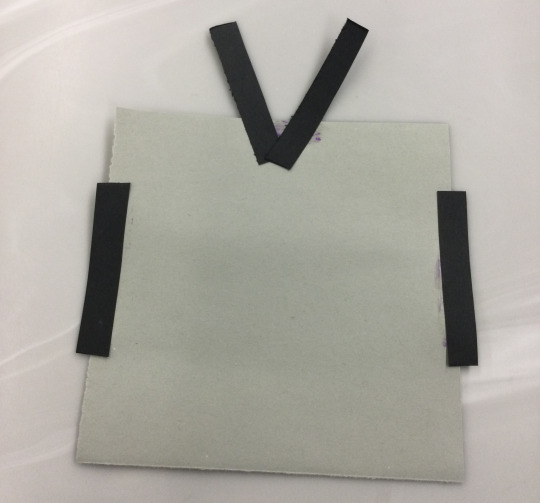
3: Turn the head over and add your white circles with your heart shaped eyes to the middle of them and add your teeth to the bottom of the square.
4: Attach the flap to the top of the head and put the remaining two white circles and then add the two black eyes to the middle.


5: Test the flap to see how it works, and congratulations! You have a robot in love.
Check out Robot in Love by T.L. McBeth
#robot in love#t.l. mcbeth#kids' books#print awareness#vocab builder#narrative skills#talking#reading#playing#early literacy#ecrr extension activities
4 notes
·
View notes
Text
Pen Pals by Alexandra Pichard
This book follows the exchanging of letters between two friends, Oscar and Bill. Oscar is an ant. Bill is an Octopus. Watch their friendship grow as you read the letters they send back and forth to each other.
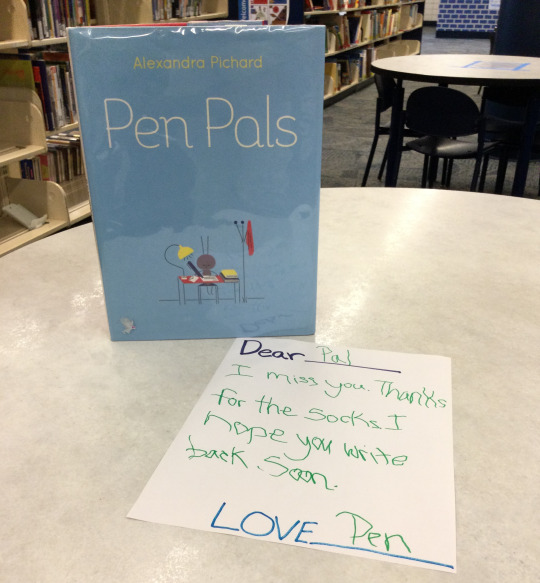
Pen Pals will help build print awareness, vocabulary, background knowledge, and narrative skills.
This book also builds early literacy skills such as talking, reading, and writing.
Extend the book by writing a letter to a friend or family member
Even if your little one can not write yet, this is a great time to practice picking up a marker and just doodling to understand the concept.
What you will need:
1 blank piece of paper, with or without lines.
Plenty of markers
Adult: write at the top of the paper the word DEAR with a line and at the bottom the paper, the word LOVE or FROM with a line. This will be so you can practice writing names and showing your child where they would go on a letter.

2. Allow your child to write whatever they would like the paper. You can practice words or just let them doodle.
3. When they are done, ask if they would like to send it to their friend. If not, keep it on the fridge.
Check out Pen Pals by Alexandra Pichard
#pen pals#alexandra pichard#kids' books#early literacy#print awareness#vocab builder#background knowledge#narrative skills#writing#writing practice#reading#talking#ecrr extension activities
0 notes
Text
Walking in a Winter Wonderland
song by Felix Bernard and Richard B. Smith, as sung by Peggy Lee; Book illustrated by Tim Hopgood.
Sleigh bells ring, are you listening? The popular Christmas carol is beautifully illustrated by Tim Hopgood in this book.

Sing the song aloud with your kids while you flip through the book. Each page is a winter wonderland!
After singing the song together, ask your child to tell you a story based on the images. The illustrations offer lots of details that your kids can point out.
Ask your child questions like, 'where are the people going?' and 'what are they looking at?' to help them narrate a story.
Reading in this way will help your child practice singing, talking, and playing, which will help them get ready to read on their own. They'll build phonological awareness, narrative skills, vocabulary, and background knowledge.
Extend the Book: Winter Wonderland Calm Down Jar
You will need:
Bottle with cap or mason jar
Permanent marker
Clear school glue
Glitter
Food coloring
Beads, rhinestones, styrophoam balls, or other small items to float in your jar


Draw a winter scene on the outside of your jar with permanent marker.
Add a large scoop of glitter to your jar along with a handful of beads, rhinestones, Styrofoam balls, or other objects you have gathered.
Pour about 2oz of clear school glue into the jar. The glue will help make the jar settle more slowly after shaking it up.
Fill the rest of the container with water, pouring slowly so you don't create too many bubbles. Stir to dissolve the glue.
Add one drop of food coloring (more than one drop will make it difficult to see the objects inside.)
Put the top back on and seal tightly. Have an adult hot glue around the lid to prevent leaks.
Shake the jar to create a winter wonderland. Then watch as the particles settle slowly to the bottom.
Check out Walking in a Winter Wonderland!
#walking in a winter wonderland#picture book#kids' books#tim hopgood#felix bernard#richard b smith#peggy lee#song books#winter books#singing#talking#playing#phonological awareness#narrative skills#vocabulary#background knowledge#ecrr extension activities
3 notes
·
View notes
Text
Soup Day by Melissa Iwai
A little girl and her Mommy spend the day making soup together. They pick out the vegetables, chop them up and simmer them in the pot while they play. Mommy even lets her pick out the pasta. She chooses alphabet pasta!

This cozy picture book is the perfect read for a chilly winter day. It even includes a recipe for Snowy Day Vegetable Soup.
This book helps kids practice reading, writing, and talking. It also helps build letter knowledge, vocabulary, and background knowledge. All of these are important for helping kids get ready to read on their own!
Extend the book with an alphabet 'soup' activity!
Make your child a bowl of alphabet 'soup'. Kids can use a slotted spoon to scoop up letters as you spell simple words together.
This activity was inspired by the alphabet soup activities at The Kindergarten Connection. We made our own twist on it, but check out their blog for even more alphabet activities you can do with your 'soup'!
You will need:
-Letter tiles or shapes (I'm using Scrabble tiles, but you can use any waterproof alphabet shapes, like refrigerator magnets or puzzle pieces.)
-Large bowl
-Water
-Slotted Spoon
-Dry erase board (or a piece of paper inside a clear sheet protector)
-Dry erase marker
-Small waterproof toys
1: Add letters to a large bowl with some water. You can include other small toys to make this project a little more challenging. I added Lego bricks, marbles, and dice.

2: Write your child's name, or a simple word on the dry erase board.
3: Ask your child to scoop each letter of the word out of the water, then match the letters to the word you have written on the board.

Check out Soup Day!
#soup day#melissa iwai#kids' books#picture books#alphabet soup#vocab builder#background knowledge#letter knowledge#spelling#reading#ecrr extension activities#writing#talking
0 notes
Text
Rumble and Roar: Sound Around the World
by Sue Fliess, illustrated by Khoa Le
Rumble and Roar Sound Around the World is a book all about putting words to sounds!

Children can use phonological awareness to help them read and there is a great amount of onomatopoeia throughout the book that will encourage letter knowledge.
Children are using talking and reading skills as they say the words and sounds, and on some pages the rhymes!
Extend the Book with a Noisemaker Craft!
You Will Need:
2 Cups
Things to put inside the cups. I used pony beads.
Tape
Markers
Put the pony beads in one of the cups.
Attach the other cup with tape to secure the beads inside.
Decorate the outside.

You now have a noisemaker! Talk about what sound the noisemaker makes, and experiment by putting different items inside the cups to see how the noises change!
Check out Rumble and Roar: Sound Around the World
#rumble and roar: sound around the world#sue fliess#khoa le#kids' books#picture books#phonological awareness#letter knowledge#reading#talking#early reading skills#early literacy#ecrr extension activities
0 notes
Text
A Day So Gray by Marie Lamba
Experience the world through colors through this story of two friends. They use vocabulary to name the colors and explore objects.

The story of the two girls helps work on reading and narrative skills and following along with parts of a story. Their journey throughout the book encourages playing and a love for nature!
Extend the Book with a Colorful Sweater Craft!
Make your sweater as colorful as possible to cheer up the gray days!
You will need:
White paper
colored pencils
crayons
markers
glitter glue is optional!
Draw a sweater, cut it out, then decorate it with as many colors as possible or using the colors mentioned in the story.
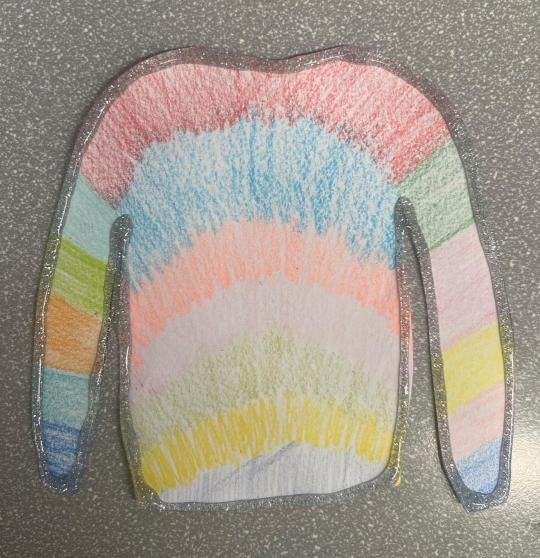
Check out A Day So Gray
#a day so gray#marie lamba#kids' books#picture books#vocab builder#narrative skills#playing#reading#reading practice#early literacy#colors#ecrr extension activities
0 notes
Text
Tiptoe Tiger by Jane Clarke, illustrated by Britta Teckentrup
Tiptoe Tiger follows tiger cub Tara as she explores the jungle before bedtime. She needs to tiptoe so she doesn't scare the other animals, but she keeps scaring them away!

As you read this story, make it into a game, encouraging your child to play with you by guessing what animal is coming next that Tara is going to scare. This encourages background knowledge as well as vocabulary.
Talk and build vocabulary with your child by discussing what is happening in the pages, and what they think will happen next, building narrative skills.
Extend the Book with a Jumping Tiger Craft
Supplies:
Orange, white, and black construction paper.
scissors
glue stick
markers or crayons
2 paper or plastic cups
rubber band
googly eyes (optional)
Steps:
Cut out two circles of orange (one slightly smaller than the other), 15 black triangles for stripes, and two white circles (one will be the belly fur and one will me the muzzle fur). If your child can use scissors, encourage them to cut out the pieces themselves. Free cutting exercises are a great activity for children to practice.
Once the pieces are cut out, your child can glue them together into the shape of a tiger. Use googly eyes or use the white construction paper to cut out small circles for the eyes.
Adults can next take the paper/plastic cup and make two cuts about an inch long on either side of your cup. Take the rubber band and fit it through the slits on one side twist in the middle and then fit it in through the other side of the cup. The rubber band should now be stretched across the inside of your cup.


4. Next, glue the tiger to the front of the cup with the rubber band in it, making sure that the cup is face down.
5. Finally, stack the tiger cup on top of the other cup, press down slightly, and watch your tiger jump!
#tiptoe tiger#jane clarke#britta teckentrup#kids' books#kids' crafts#animal books#vocab builder#print awareness#background knowledge#narrative skills#reading#talking#playing#early literacy#ecrr extension activities
0 notes
Text
ABCity by Roxie Munro
ABCity is both a maze and seek-and-find. Readers follow a teeny tiny Chris and his dog Rusty as they walk through the city in search of a park.

Along the way, each double page spread shows large alphabet letter buildings that lead the reader from A-Z, as well as a seek-and-find of different things that start with those letters hidden on the page.
By making the book a maze, this is a wonderful way to play with children while they learn about the alphabet and consider new vocabulary.
While reading this book, go over the vocabulary presented in the seek-and-find.
Ask if they know any other words that start with the letters on the page. This encourages vocabulary and background knowledge.
Trace a finger on the building letters. By doing so children work on print awareness, letter awareness, and writing skills.
Play with your child by asking them what is happening on certain pages. Talk to them about different buildings in your own city.
Extend the Book with a Letter Search Craft
Supplies:
Magazines/ or junk mail you don't mind being cut up
scissors
glue
crayons or markers
Steps:
Help your child look through the magazine or junk mail you've chosen for the letters of their name. Choose large fonts that are easy to cut out.
Cut out the letters as you find them and help your child glue them to a page of construction paper.
Next, let your child make a picture around their name. This can be an abstract picture, or they can make a city-scape as seen in the book.
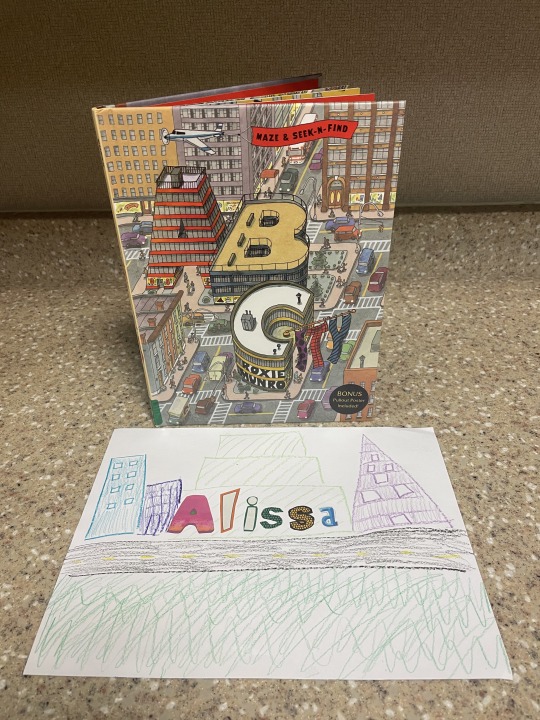

#ABCity#roxie munro#kids' books#early literacy#ecrr extension activities#vocab builder#print awareness#background knowledge#letter knowledge#talking#reading#writing#playing
0 notes
Text
Where's My Mummy? by Carolyn Crimi, illustrated by John Manders
This book is one of my most favorite read-alouds for Halloween storytimes. The illustrations are beautiful and Little Baby Mummy is an endearing and adorable main character.
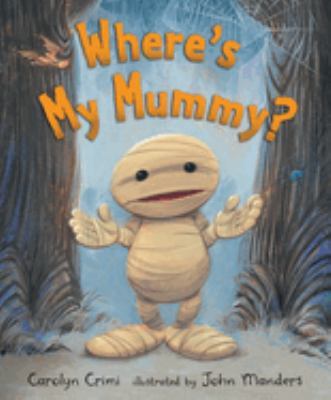
The book offers many different talking points- your child can use their narrative skills to guess what will happen next, as well as reviewing their background knowledge about each of the characters we meet in the book.
As you read the book together, you can also point out the new and fun vocabulary, such as “gargled,” “glug,” and “glob,” just to name a few.
Extend the book with the Toilet Paper Mummy Wrap game!

It's best to do this game with at least 4 players in teams of 2, if not more. However, it can just be a fun activity with a child or parent where the parent or child is the mummy. You can also wrap dolls instead of people.
The idea is that each team gets a roll of toilet paper and the first team to wrap their mummy and use up their toilet paper wins. We recommend not covering the nose or mouth too much.

#halloween#halloween books#where's my mummy#carolyn crimi#john manders#background knowledge#narrative skills#vocab builder#playing#talking#reading#early literacy#kids books#ecrr extension activities
0 notes
Text
Monster Mash by David Catrow
The classic Halloween hit “Monster Mash” has been made into a children's picture book!
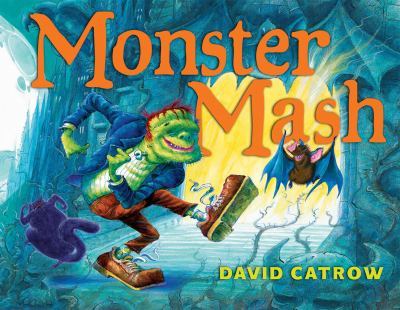
Feel free to read or sing the book aloud to your little one. Singing can help build your child's phonological awareness because it focuses on the rhythm and rhyme structure of the story.
You can talk about the different ghouls and goblins you encounter on every page, which will help build up your child's background knowledge.
The book also provides ample opportunity for new vocabulary with lines such as, “The ghouls all came from their humble abodes to get a jolt from my electrodes.”
Extend the book by dancing!

Search for “Monster Mash” by Bobby “Boris” Pickett and the Crypt Kickers (or any of its covers) and do the mash!
#halloween#halloween books#monster mash#david catrow#background knowledge#vocab builder#phonological awareness#reading#singing#talking#early literacy#ecrr extension activities#kids books
0 notes
Text
What's Your Name? by Bethanie Deeney Murguia
This book celebrates the importance of having a name. The pages are filled with names and how we might have gotten our names.

The book tells us how to introduce ourselves, and how we can share our name with others. A name is a great way to identify and share a bit about you.
Early Literacy Skills:
Vocabulary - Your child will develop their vocabulary by learning the many names that people have.
Print Awareness - Names fill the pages of this book. Conversation bubbles with names show how we communicate our names or use a name to address a person.
Letter Knowledge - Your child will see capital and lowercase letters in the names in the book. They will see that some letters have similarities, or they will hear when you read the different sounds of the letters in a name out loud.
Early Literacy Practice:
Children may know the first letter in their name. Talk with your child about other words that start with the first letter of their name.
Sing the ABCs with your child to learn the letters that make up a name.
Have your child play with different textures to learn to write other letters.
Extend the book:
This craft is great to help your little one learn their letters and how to spell their name.
You will need:
White Construction Paper
Miscellaneous Color Construction Paper
Black Marker
Scissors
Glue
Instructions:
Cut out a cloud from the white construction paper. Trim around the edges as needed.
Cut strips out multiple stripes of the different color construction paper. Cut as many as you need to spell out your child’s name.

Help your child write out their name on the cloud.
Help spell out their name by adding a letter to each strip. You’ll want to put the letter at the bottom of the strip.
Glue the strips to the back of the cloud. Make sure the name and letters are visible on the same side.
Optional step: You can outline the cloud with a black marker.
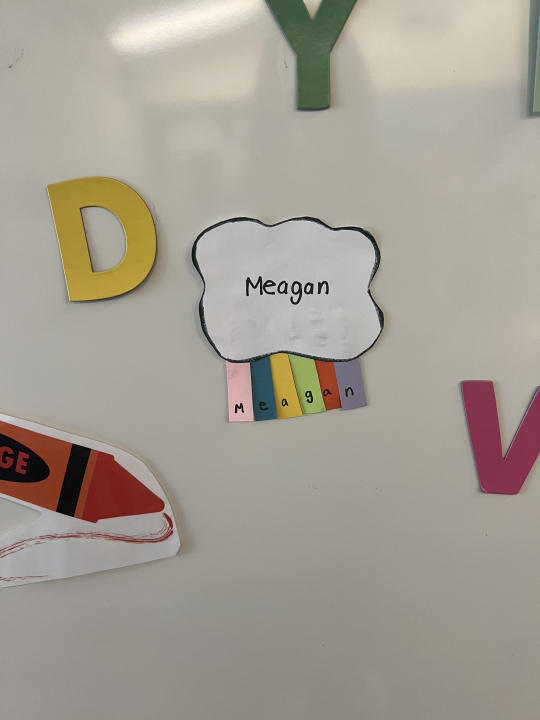
#what's your name?#bethanie deeney murguia#kids books#spelling practice#vocab builder#print awareness#letter knowledge#talking#singing#playing#writing#early literacy#ecrr extension activities#kids craft
1 note
·
View note
Text
Boop! by Bea Birdsong, illustrated by Linzie Hunter
All the dog snoots in this book are boop-able!

In this picture, a friendly neighborhood dog named Aletheia stopped by for a visit. Miss Meagan asked Aletheia’s adult to boop her nose and shared this fun book with them.
In this interactive book, readers will boop all the different dog noses. Learn about the many different sizes, textures, and kinds of dog snoots in this bright and fun book.
Early Literacy Skills:
Print Awareness - There are bright and colorful words all over the pages. Readers must turn the book sideways to read a few pages in the story.
Vocabulary - Synonyms such as snoot, nose, boop, and tap help build a child’s vocabulary.
Background knowledge - Ask what your child knows about dogs. What sounds do they make? What is a dog’s favorite treat? How do you take care of a dog?
Early Literacy Practices:
Talk to your child about animal safety. This book is a great guide to help children understand animal safety, even around pets. Talking helps develop your child’s vocabulary and communication skills.
Reading with your child and having fun with the story will encourage them to want to read more!
This book is great for travel or reading at the park. You and your child can play a game of finding similar dogs that are in the book.
Extend the Book!
It is important that you do not boop a real dog’s nose without permission.
Always ask your adult and the dog’s adult for permission before petting or booping a snoot.
Highland, Hobart, Munster, Dyer-Schererville, and St. John branches of LCPL host a dog reading program where you can safely and kindly boop the dog's nose. Check out our online calendar for dates and times.
#boop the snoot#print awareness#vocab builder#background knowledge#talking#reading#playing#dogs#dog books#kids books#early literacy#ecrr extension activities#boop!#bea birdsong#linzie hunter
1 note
·
View note
Text
Everybunny Count! by Ellie Sandall
Counting is such a needed skill for those under the age of 5 to learn. This book allows you to count with your child in a fun and cute way with bunnies.

This book helps with reading, counting, recognizing animals, and rhyming.
Extend the book with a bunny hunt!
You will need:
scissors
a trace out of a bunny
at least 10 pieces of colored paper
Trace the bunny out on all pieces of paper.
Cut out all of the bunnies.
Put the bunnies all over the house and work on finding and counting them all, at least up to ten.

Check out Everybunny Count! from LCPL
#everybunny count#ellie sandall#kids books#ecrr extension activities#print awareness#background knowledge#reading#playing#early literacy
0 notes